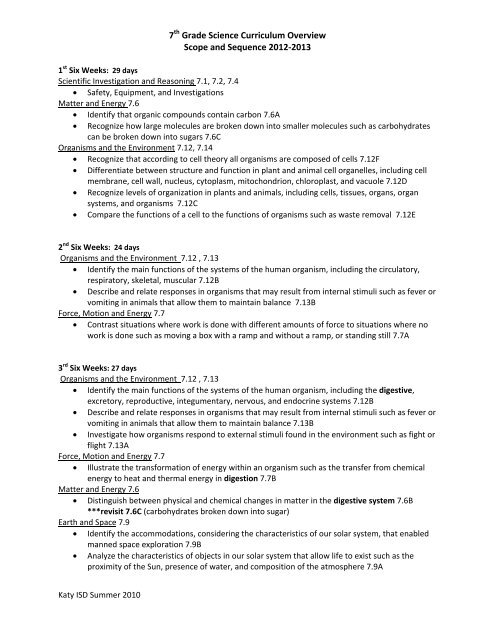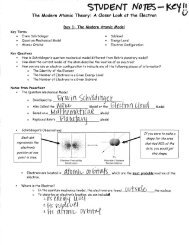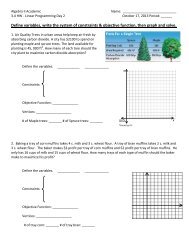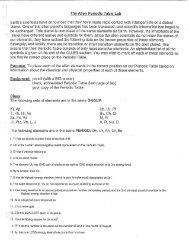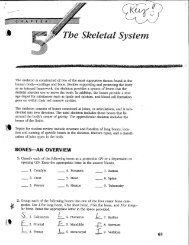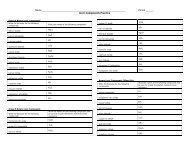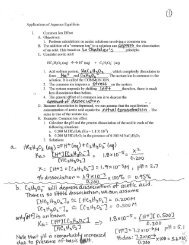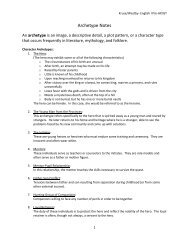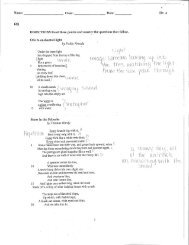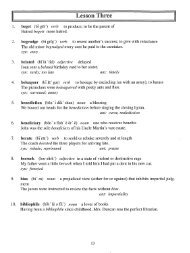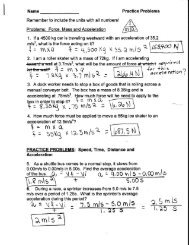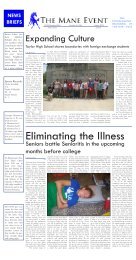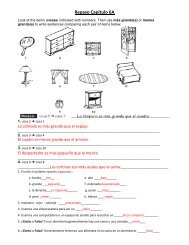7th_Grade_Science_Scope_and_Sequence_2012-2013 - Katy ISD
7th_Grade_Science_Scope_and_Sequence_2012-2013 - Katy ISD
7th_Grade_Science_Scope_and_Sequence_2012-2013 - Katy ISD
Create successful ePaper yourself
Turn your PDF publications into a flip-book with our unique Google optimized e-Paper software.
<strong>Katy</strong> <strong>ISD</strong> Summer 2010<br />
7 th <strong>Grade</strong> <strong>Science</strong> Curriculum Overview<br />
<strong>Scope</strong> <strong>and</strong> <strong>Sequence</strong> <strong>2012</strong>-<strong>2013</strong><br />
1 st Six Weeks: 29 days<br />
Scientific Investigation <strong>and</strong> Reasoning 7.1, 7.2, 7.4<br />
• Safety, Equipment, <strong>and</strong> Investigations<br />
Matter <strong>and</strong> Energy 7.6<br />
• Identify that organic compounds contain carbon 7.6A<br />
• Recognize how large molecules are broken down into smaller molecules such as carbohydrates<br />
can be broken down into sugars 7.6C<br />
Organisms <strong>and</strong> the Environment 7.12, 7.14<br />
• Recognize that according to cell theory all organisms are composed of cells 7.12F<br />
• Differentiate between structure <strong>and</strong> function in plant <strong>and</strong> animal cell organelles, including cell<br />
membrane, cell wall, nucleus, cytoplasm, mitochondrion, chloroplast, <strong>and</strong> vacuole 7.12D<br />
• Recognize levels of organization in plants <strong>and</strong> animals, including cells, tissues, organs, organ<br />
systems, <strong>and</strong> organisms 7.12C<br />
• Compare the functions of a cell to the functions of organisms such as waste removal 7.12E<br />
2 nd Six Weeks: 24 days<br />
Organisms <strong>and</strong> the Environment 7.12 , 7.13<br />
• Identify the main functions of the systems of the human organism, including the circulatory,<br />
respiratory, skeletal, muscular 7.12B<br />
• Describe <strong>and</strong> relate responses in organisms that may result from internal stimuli such as fever or<br />
vomiting in animals that allow them to maintain balance 7.13B<br />
Force, Motion <strong>and</strong> Energy 7.7<br />
• Contrast situations where work is done with different amounts of force to situations where no<br />
work is done such as moving a box with a ramp <strong>and</strong> without a ramp, or st<strong>and</strong>ing still 7.7A<br />
3 rd Six Weeks: 27 days<br />
Organisms <strong>and</strong> the Environment 7.12 , 7.13<br />
• Identify the main functions of the systems of the human organism, including the digestive,<br />
excretory, reproductive, integumentary, nervous, <strong>and</strong> endocrine systems 7.12B<br />
• Describe <strong>and</strong> relate responses in organisms that may result from internal stimuli such as fever or<br />
vomiting in animals that allow them to maintain balance 7.13B<br />
• Investigate how organisms respond to external stimuli found in the environment such as fight or<br />
flight 7.13A<br />
Force, Motion <strong>and</strong> Energy 7.7<br />
• Illustrate the transformation of energy within an organism such as the transfer from chemical<br />
energy to heat <strong>and</strong> thermal energy in digestion 7.7B<br />
Matter <strong>and</strong> Energy 7.6<br />
• Distinguish between physical <strong>and</strong> chemical changes in matter in the digestive system 7.6B<br />
***revisit 7.6C (carbohydrates broken down into sugar)<br />
Earth <strong>and</strong> Space 7.9<br />
• Identify the accommodations, considering the characteristics of our solar system, that enabled<br />
manned space exploration 7.9B<br />
• Analyze the characteristics of objects in our solar system that allow life to exist such as the<br />
proximity of the Sun, presence of water, <strong>and</strong> composition of the atmosphere 7.9A
4 th Six Weeks: 32 days<br />
Organisms <strong>and</strong> the Environment 7.14, 7.12, 7.11, 7.13<br />
• Compare the results of uniform or diverse offspring from sexual reproduction or asexual<br />
reproduction 7.14B<br />
• Define heredity 7.14 A<br />
• Recognize that inherited traits of individuals are governed in the genetic material found in the<br />
genes within chromosomes in the nucleus 7.14C<br />
• Investigate <strong>and</strong> explain how internal structures of organisms have adaptations that allow<br />
specific functions such as gills in fish, hollow bones in birds 7.12A<br />
• Identify some changes in genetic traits that have occurred over several generations through<br />
natural selection <strong>and</strong> selective breeding such as the Galapagos Medium Ground Finch (Geospiza<br />
fortis) or domestic animals 7.11C<br />
• Explain variation within a population or species by comparing external features, behaviors, or<br />
physiology of organisms that enhance their survival such as migration, hibernation 7.11B<br />
• Examine organisms or their structures such as insects or leaves <strong>and</strong> use dichotomous keys for<br />
identification 7.11A<br />
5 th Six Weeks: 34 days<br />
Matter <strong>and</strong> Energy 7.5<br />
• Recognize that radiant energy from the Sun is transformed into chemical energy through the<br />
process of photosynthesis 7.5A<br />
• Diagram the flow of energy through living systems, including food chains, food webs, <strong>and</strong> energy<br />
pyramids 7.5C<br />
• Demonstrate <strong>and</strong> explain the cycling of matter within living systems such as in the decay of<br />
biomass in a compost bin 7.5B<br />
Organisms <strong>and</strong> the Environment 7.10<br />
• Describe how biodiversity contributes to the sustainability of an ecosystem 7.10B<br />
• Observe <strong>and</strong> describe how different environments, including microhabitats in schoolyards <strong>and</strong><br />
biomes, support different varieties of organisms 7.10A<br />
Force, Motion <strong>and</strong> Energy 7.7<br />
• Demonstrate <strong>and</strong> illustrate forces that affect motion in everyday life such as emergence of<br />
seedlings, turgor pressure, <strong>and</strong> geotropism 7.7C<br />
Organisms <strong>and</strong> the Environment 7.12<br />
• Investigate <strong>and</strong> explain how internal structures of organisms have adaptations that allow<br />
specific functions such as xylem in plants 7.12A<br />
• Investigate how organisms respond to external stimuli found in the environment such as<br />
phototropism 7.13A<br />
• Explain variation within a population or species by comparing external features, behaviors, or<br />
physiology of organisms that enhance their survival such as storage of food in a bulb 7.11B<br />
6 th Six Weeks: 32 days<br />
Organisms <strong>and</strong> the Environment 7.10<br />
• Observe, record, <strong>and</strong> describe the role of ecological succession such as in a microhabitat of a<br />
garden with weeds 7.10C<br />
Earth <strong>and</strong> Space 7.8<br />
• Predict <strong>and</strong> describe how different types of catastrophic events impact ecosystems such as<br />
floods, hurricanes, or tornadoes 7.8A<br />
• Analyze the effects of weathering, erosion, <strong>and</strong> deposition on the environment in ecoregions of<br />
Texas 7.8B<br />
• Model the effects of human activity on groundwater <strong>and</strong> surface water in a watershed 7.8C<br />
<strong>Katy</strong> <strong>ISD</strong> Summer 2010


